6th Air Refueling Squadron
6th Air Refueling Squadron
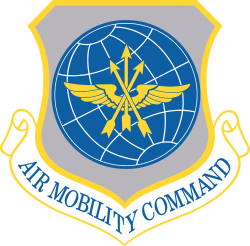 | |
|---|---|
 A KC-10 Extender from Travis AFB refuels an F-22 Raptor | |
| Active | 1940-1946; 1947-1949; 1951-1951; 1957-1967; 1989 – present |
| Country |
|
| Branch |
|
| Role | Air Refueling |
| Part of | Air Mobility Command |
| Garrison/HQ | Travis Air Force Base |
| Motto(s) | Vis Extensa Latin Strength Extended (1960-present) |
| Engagements |
World War II Antisubmarine Pacific Theater of Operations[1] |
| Decorations |
Distinguished Unit Citation Air Force Meritorious Unit Award Air Force Outstanding Unit Award |
| Insignia | |
| 6th Air Refueling Squadron emblem (approved 9 December 1994)[1] |
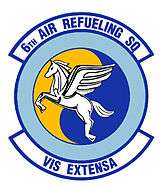 |
| Patch with 6th Air Refueling Squadron emblem (approved 12 October 1960)[2] |
.png) |
| 6th Bombardment Squadron emblem (approved 6 April 1942)[3] |
 |
| Aircraft flown | |
| Tanker | McDonnell Douglas KC-10 Extender |
The 6th Air Refueling Squadron is part of the 60th Air Mobility Wing at Travis Air Force Base, California. It operates the McDonnell Douglas KC-10 Extender aircraft conducting air refueling missions.
The squadron was first active during World War II as the 6th Bombardment Squadron. Following the Attack on Pearl Harbor, the squadron augmented Navy operations against German submarines in the Gulf of Mexico. When the U-Boat threat diminished, it became a heavy bomber training unit. In 1944, it was reorganized as a Boeing B-29 Superfortress unit, and participated in the strategic bombing campaign against Japan, earning two Distinguished Unit Citations, before inactivating on Guam. After the end of the war, the squadron served in the reserves from 1947 until 1949.
In 1951, the 6th Air Refueling Squadron was activated for a brief time, but was inactivated when its parent wing converted to Convair B-36 Peacemakers, which did not require air refueling. It was activated again in 1957 and served with Strategic Air Command for the next ten years, inactivating when Walker Air Force Base closed. Until 1962, it served as a crew training unit.
The two squadrons were consolidated into a single unit in 1985. The consolidated squadron was activated again in 1989 as the 6th Air Refueling Squadron to operate the McDonnell Douglas KC-10 Extender.
History
World War II
Antisubmarine warfare and heavy bomber training
The squadron was first activated at Langley Field, Virginia, as the 6th Bombardment Squadron in January 1940, one of the original squadrons of the 29th Bombardment Group. Its organization was part of the pre-World War II buildup of the United States Army Air Corps after the breakout of war in Europe. In May, it moved to MacDill Field, Florida, where it was equipped with a mix of pre-production YB-17s and early model Boeing B-17 Flying Fortresses and Douglas B-18 Bolos. The squadron was still at MacDill when the Japanese attacked Pearl Harbor, and it began to fly antisubmarine patrol missions in the Gulf of Mexico from January 1942.[3] By the summer of 1942, the U-boat threat in the Gulf began to diminish, with all German submarines being withdrawn from the area by September.[4]
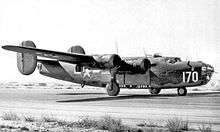
No longer needed in the Gulf, the squadron moved to Gowen Field, Idaho, where it became an Operational Training Unit (OTU)[3] The OTU program involved the use of an oversized parent unit to provide cadres to "satellite groups".[5] The 96th, 381st, 384th and 388th Bombardment Groups were all formed at Gowen in the second half of 1942.[6][7]
In 1943, the squadron exchanged its B-17s for Consolidated B-24 Liberators. The squadron mission also changed as the Army Air Forces' (AAF) need for new units diminished and its need for replacements increased. The squadron became a Replacement Training Unit (RTU).[3] Like OTUs, RTUs were oversized units, but their mission was to train individual pilots and aircrews. However, standard military units, like the 6th Squadron, were based on relatively inflexible tables of organization, and were not proving well adapted to the training mission. Accordingly a more functional system was adopted in which each base was organized into a separate numbered unit.[8] The 29th Bombardment Group and its squadrons (including the 6th) were inactivated. Its personnel and equipment, along with that of supporting units at Gowen Field were combined into the 212th AAF Base Unit (Combat Crew Training School, Heavy) on 1 April 1944.[3][9][10]
Combat in the Pacific
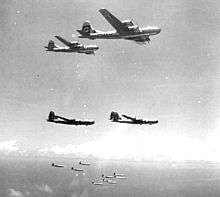
The AAF was organizing new Boeing B-29 Superfortress very heavy bombardment units, and the squadron was activated the same day at Pratt Army Air Field, Kansas. It briefly returned to flying B-17s until B-29s became available for training. It continued training with the Superfortress until December 1944.[1] Training included long range overwater flights to Borinquen Field, Puerto Rico.[11]
It deployed to North Field, Guam, where it became a component of the 314th Bombardment Wing of XXI Bomber Command. Its first combat mission was an attack of Tokyo on 25 February 1945. Until March 1945, it engaged primarily in daytime high altitude attacks on strategic targets, such as refineries and factories. The campaign against Japan switched that month and the squadron began to conduct low altitude night raids, using incendiaries against area targets. The squadron received a Distinguished Unit Citation (DUC) for a 31 March attack against an airfield at Omura, Japan. The squadron earned a second DUC in June for an attack on an industrial area of Shizuoka Prefecture, which included an aircraft factory operated by Mitsubishi and the Chigusa Arsenal.[9]
During Operation Iceberg, the invasion of Okinawa, the squadron was diverted from the strategic campaign against Japanese industry and attacked airfields from which kamikaze attacks were being launched against the landing force. Following VJ Day, the squadron dropped food and supplies to Allied prisoners of war and participated in several show of force missions over Japan.[9] It also conducted reconnaissance flights over Japanese cities.[12] The squadron remained on Guam until it was inactivated in March 1946.[1]
Reserve operations
The squadron was activated in the reserve at Barksdale Field, Louisiana in June 1947. Although nominally a bomber unit, the squadron used training aircraft to maintain proficiency under the supervision of the 174th AAF Base Unit (later the 2509th Air Force Reserve Training Center), and it is unclear whether it was fully manned.[1][13] In September, the squadron was assigned to the 482d Bombardment Group, which was located at New Orleans Municipal Airport, Louisiana. President Truman’s 1949 defense budget required reductions in the number of units in the Air Force.[14] At the same time, Continental Air Command was converting its reserve units to the wing-base organization system. As a result, the squadron was inactivated in June 1949, as the 392d Bombardment Group absorbed the remaining reservists at Barksdale.[1][13]
Air refueling operations
Strategic Air Command
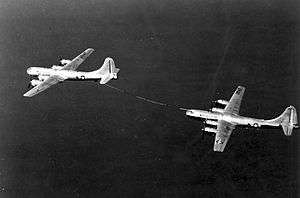
The 6th Air Refueling Squadron was activated at Walker Air Force Base, New Mexico in April 1951 and began to train with the KB-29 tanker version of the Superfortress. The bombardment squadrons of the 6th's parent 6th Bombardment Group were flying B-29s as well, but plans were underway by late summer to convert the group to Convair B-36 Peacemaker bombers, which lacked an air refueling capability. The squadron was inactivated on 1 August and its crews and airplanes were transferred to the 307th Air Refueling Squadron, which moved to Walker on paper from Davis-Monthan Air Force Base, Arizona.[1][15]
By 1957, the 6th Bombardment Wing had transitioned to the Boeing B-52 Stratofortress and, therefore, once again had a need for air refueling aircraft.[16] Meanwhile, at Bergstrom Air Force Base, Texas, Strategic Air Command (SAC) had transferred the fighters of its 27th Strategic Fighter Wing to Tactical Air Command in July 1957,[17] but retained the 27th Wing's 27th Air Refueling Squadron. On 1 November, the 6th Squadron was again activated at Bergstrom,[1] where it absorbed the remaining personnel of the 27th Squadron.[18][note 1]
In January 1958, the squadron returned to Walker AFB and the 6th Wing, where it began to fly the new Boeing KC-135 Stratotanker. Until 1962, when tanker training was concentrated at Castle Air Force Base, California, the squadron acted as a combat crew training unit for crews on the KC-135.[1] Once its training mission was transferred, the squadron maintained half its aircraft on alert status. The squadron continued to maintain this alert commitment until shortly before its inactivation.[19] The squadron also flew worldwide air refueling missions, including support of tactical aircraft flying in Southeast Asia.[1]
During the Cuban Missile Crisis, SAC placed 2 additional B-52s from each of its wings on ground alert[note 2] and placed 1/8 of its B-52 force on airborne alert. To support the expanded bomber alert force, additional KC-135 tankers had to be placed on alert.[20] On 24 October 1962, SAC went to DEFCON 2, placing all the squadron's remaining aircraft on alert.[21]
In December 1965, the first B-52Bs started leaving the operational inventory. This reduction resulted in the end of 6th Wing activities at Walker including the inactivation of the squadron,[1] and the closure of Walker Air Force Base in 1967.[22]
On 19 September 1985 the 6th Air Refueling Squadron was consolidated with the 6th Bombardment Squadron.[1]
Air Mobililty Command
The consolidated squadron was activated in 1989 at March Air Force Base, California as a McDonnell Douglas KC-10 Extender unit and assigned to the 22d Air Refueling Wing. The squadron again flew worldwide air refueling, including support of deployments to Southwest Asia from 1990 through 1991. In June 1992, the Air Force reorganized its major commands. This reorganization involved the transfer of the 22d Wing to the new Air Mobility Command,[23] which combined air refueling and airlift elements of the Air Force into a single command.[24] Under the new command, the squadron provided humanitarian airlift to Somalia from 1992 to 1993.[1]
The 1991 Base Realignment and Closure Commission recommended that March be transferred to Air Force Reserve Command. As a result of the turnover to the reserves, the 22d Wing moved to McConnell Air Force Base, Kansas in January 1994.[23] The squadron remained at March until August 1995, when it moved to Travis Air Force Base, California and became part of the 60th Air Mobility Wing. In the interim, it was assigned to the 722d Operations Group, which controlled regular flying units at March until the base was fully converted to a reserve base. Since 2001, the squadron has provided air refueling support for the Global War on Terrorism[1]
Lineage
- 6th Bombardment Squadron
- Constituted as the 6th Bombardment Squadron (Heavy) on 22 December 1939
- Activated on 1 February 1940
- Redesignated 6th Bombardment Squadron, Very Heavy on 28 March 1944
- Inactivated on 1 April 1944
- Activated on 1 April 1944
- Inactivated on 20 May 1946
- Activated in the reserve on 15 June 1947
- Inactivated on 27 June 1949
- Consolidated with the 6th Air Refueling Squadron as the 6th Air Refueling Squadron on 19 September 1985[1]
- 6th Air Refueling Squadron'
- Constituted as the 6th Air Refueling Squadron, Medium on 6 April 1951
- Activated on 10 April 1951
- Inactivated on 1 August 1951
- Redesignated 6th Air Refueling Squadron, Heavy on 1 April 1957
- Activated on 1 November 1957
- Discontinued and inactivated on 25 January 1967
- Consolidated with the 6th Bombardment Squadron on 19 September 1985
- Activated on 3 January 1989
- Redesignated 6th Air Refueling Squadron on 1 September 1991[1]
Assignments
- 29th Bombardment Group, 1 February 1940 – 1 April 1944
- 29th Bombardment Group, 1 April - 20 May 1946
- Tenth Air Force, 15 June 1947
- 482d Bombardment Group, 30 September 1947 – 27 June 1949
- 6th Bombardment Group, 10 April 1951 – 1 August 1951
- Fifteenth Air Force, 1 November 1957
- 6th Bombardment Wing (later 6 Strategic Aerospace Wing), 3 January 1958 – 25 January 1967
- 22d Air Refueling Wing, 3 January 1989
- 22d Operations Group, 1 September 1991
- 722d Operations Group, 1 January 1994
- 60th Operations Group, 1 August 1995 – Present[1]
Stations
- Langley Field, Virginia, 1 February 1940
- MacDill Field, Florida 21 May 1940
- Gowen Field, Idaho 25 June 1942 – 1 April 1944
- Pratt Army Air Field, Kansas 1 April – 7 December 1944
- North Field, Guam, 17 January 1945 – 20 May 1946
- Barksdale Field (later Barksdale Air Force Base), Louisiana, 15 June 1947 – 27 June 1949
- Walker Air Force Base, New Mexico, 10 April 1951 – 1 August 1951
- Bergstrom Air Force Base, Texas, 1 November 1957
- Walker Air Force Base, New Mexico, 3 January 1958 – 25 January 1967
- March Air Force Base, California, 3 January 1989
- Travis Air Force Base, California, 1 August 1995 – Present[1]
Aircraft
- Boeing YB-17 Flying Fortress (1940)
- Boeing B-17 Flying Fortress (1940–1943, 1944)
- Douglas B-18 Bolo (1940–1941)
- Consolidated B-24 Liberator (1943–1944)
- Boeing B-29 Superfortress (1944–1946)
- North American AT-6 Texan (1947–1949)
- Beechcraft AT-11 Kansan (1947–1949)
- Boeing KB-29 Superfortress (1951)
- Boeing KC-135 Stratotanker (1958–1967)
- McDonnell Douglas KC-10 Extender (1989 – present)[1]
Awards and campaigns
| Award streamer | Award | Dates | Notes |
|---|---|---|---|
| Distinguished Unit Citation | Japan, 31 March 1945 | 6th Bombardment Squadron[1] | |
| Distinguished Unit Citation | Japan, Japan, 19-26 June 1945 | 6th Bombardment Squadron[1] | |
| Air Force Meritorious Unit Award | 1 July 2005-30 June 2007 | 6th Air Refueling Squadron[1] | |
| Air Force Outstanding Unit Award | 1 May 1960-31 May 1962 | 6th Air Refueling Squadron[1] | |
| Air Force Outstanding Unit Award | 1 February-30 June 1989 | 6th Air Refueling Squadron[1] | |
| Air Force Outstanding Unit Award | 1 July 1989-30 June 1991 | 6th Air Refueling Squadron[1] | |
| Air Force Outstanding Unit Award | 1 July 1993-30 June 1995 | 6th Air Refueling Squadron[1] | |
| Air Force Outstanding Unit Award | 1 August 1995-30 July 1997 | 6th Air Refueling Squadron[1] | |
| Air Force Outstanding Unit Award | 31 July 1997-30 June 1999 | 6th Air Refueling Squadron[1] | |
| Air Force Outstanding Unit Award | 1 July 1999-30 June 2000 | 6th Air Refueling Squadron[1] | |
| Air Force Outstanding Unit Award | 1 July 2000-30 June 2001 | 6th Air Refueling Squadron[1] | |
| Air Force Outstanding Unit Award | 1 July 2001-30 June 2003 | 6th Air Refueling Squadron[1] | |
| Air Force Outstanding Unit Award | 1 July 2003-30 June 2004 | 6th Air Refueling Squadron[1] | |
| Air Force Outstanding Unit Award | 1 July 2004-30 July 2005 | 6th Air Refueling Squadron[1] | |
| Air Force Outstanding Unit Award | 1 July 2007-30 June 2009 | 6th Air Refueling Squadron[1] |
| Campaign Streamer | Campaign | Dates | Notes |
|---|---|---|---|
| American Theater without inscription | 7 December 1941–7 December 1944 | 6th Bombardment Squadron[1] | |
| Antisubmarine | January 1942–24 June 1942 | 6th Bombardment Squadron[1] | |
| Air Offensive, Japan | 17 January 1945–2 September 1945 | 6th Bombardment Squadron[1] | |
| Western Pacific | 17 April 1945–2 September 1945 | 6th Bombardment Squadron[1] |
See also
References
Notes
- Explanatory notes
- Citations
- 1 2 3 4 5 6 7 8 9 10 11 12 13 14 15 16 17 18 19 20 21 22 23 24 25 26 27 28 29 30 31 32 33 34 35 36 37 38 Kane, Robert B. (April 29, 2010). "Factsheet 6 Air Refueling Squadron (AMC)". Air Force Historical Research Agency. Retrieved June 5, 2018.
- ↑ Endicott, p. 370
- 1 2 3 4 5 Maurer, Combat Squadrons, p. 38
- ↑ Warnock, p. 16
- ↑ Craven & Cate, Introduction, p. xxxvi
- ↑ Maurer, Combat Units, pp. 166, 269, 271, 276
- ↑ "Abstract, History 29 Bombardment Group Nov 1943". Air Force History Index. Retrieved June 5, 2018.
- ↑ Goss, p. 75
- 1 2 3 Maurer, Combat Units, pp. 81-82
- ↑ "Abstract, History Gowen Field, Feb-Mar 1945". Air Force History Index. Retrieved June 5, 2018.
- ↑ "Abstract, History 29 Bombardment Group Jan 1945". Air Force History Index. Retrieved June 6, 2018.
- ↑ "Abstract, History 29 Bombardment Group Aug-Sep 1945". Air Force History Index. Retrieved June 6, 2018.
- 1 2 See Mueller, pp. 20-21
- ↑ Knaack, p. 25
- ↑ See Ravenstein, p. 16 (307th Squadron attached to 6th Bombardment Wing, effective 1 August 1951)
- ↑ Ravenstein, pp. 16-17
- ↑ Ravenstein, p. 51
- ↑ Mueller, p. 32 (simultaneous inactivation of 27th and activation of 6th Air Refueling Squadron).
- ↑ "Abstract (Unclassified), History of the Strategic Bomber since 1945 (Top Secret, downgraded to Secret)". Air Force History Index. 1 April 1975. Retrieved March 4, 2014.
- ↑ Kipp, et al., p. 34
- ↑ Kipp, et al., p. 35
- ↑ "Abstract, History 6 Strategic Aerospace Wing Jan-Mar 1967". Air Force History Index. Retrieved June 6, 2018.
- 1 2 Robertson, Patsy L. (June 19, 2017). "Factsheet 22 Air Refueling Wing (AMC)". Air Force Historical Research Agency. Retrieved June 7, 2018.
- ↑ Haulman, Daniel L. (October 20, 2016). "Factsheet Air Mobiity Command". Air Force Historical Research Agency. Retrieved June 7, 2018.
Bibliography
![]()
- Craven, Wesley F & Cate, James L, ed. (1955). The Army Air Forces in World War II (PDF). Vol. VI, Men & Planes. Chicago, IL: University of Chicago Press. LCCN 48003657. OCLC 704158. Retrieved December 17, 2016.
- Goss, William A. (1955). "The Organization and its Responsibilities, Chapter 2 The AAF". In Craven, Wesley F & Cate, James L. The Army Air Forces in World War II (PDF). Vol. VI, Men & Planes. Chicago, IL: University of Chicago Press. LCCN 48003657. OCLC 704158. Retrieved December 17, 2016.
- Endicott, Judy G. (1998). Active Air Force Wings as of 1 October 1995 and USAF Active Flying, Space, and Missile Squadrons as of 1 October 1995 (PDF). Air Force History and Museums Program. Washington, DC: Office of Air Force History. ASIN B000113MB2. Retrieved July 2, 2014.
- Kipp, Robert; Peake, Lynn; Wolk, Herman. "Strategic Air Command Operations in the Cuban Crisis of 1962, SAC Historical Study No. 90 (Top Secret NOFORN, FRD, redacted and declassified)". Strategic Air Command. Retrieved November 21, 2014.
- Knaack, Marcelle Size (1978). Encyclopedia of US Air Force Aircraft and Missile Systems (PDF). Vol. 2, Post-World War II Bombers 1945-1973. Washington, DC: Office of Air Force History. ISBN 0-912799-59-5. Retrieved December 17, 2016.
- Maurer, Maurer, ed. (1983) [1961]. Air Force Combat Units of World War II (PDF) (reprint ed.). Washington, DC: Office of Air Force History. ISBN 0-912799-02-1. LCCN 61060979. Retrieved December 17, 2016.
- Maurer, Maurer, ed. (1982) [1969]. Combat Squadrons of the Air Force, World War II (PDF) (reprint ed.). Washington, DC: Office of Air Force History. ISBN 0-405-12194-6. LCCN 70605402. OCLC 72556. Retrieved December 17, 2016.
- Mueller, Robert (1989). Air Force Bases, Vol. I, Active Air Force Bases Within the United States of America on 17 September 1982 (PDF). Washington, DC: Office of Air Force History. ISBN 0-912799-53-6. Retrieved December 17, 2016.
- Ravenstein, Charles A. (1984). Air Force Combat Wings, Lineage & Honors Histories 1947-1977 (PDF). Washington, DC: Office of Air Force History. ISBN 0-912799-12-9. Retrieved December 17, 2016.
- Warnock, Timothy. "The Battle Against the U-Boat in the American Theater" (PDF). Bolling AFB, DC: Air Force History Support Office. Retrieved June 22, 2015.


.png)
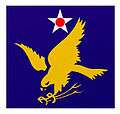
.svg.png)